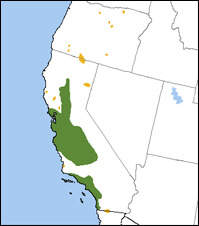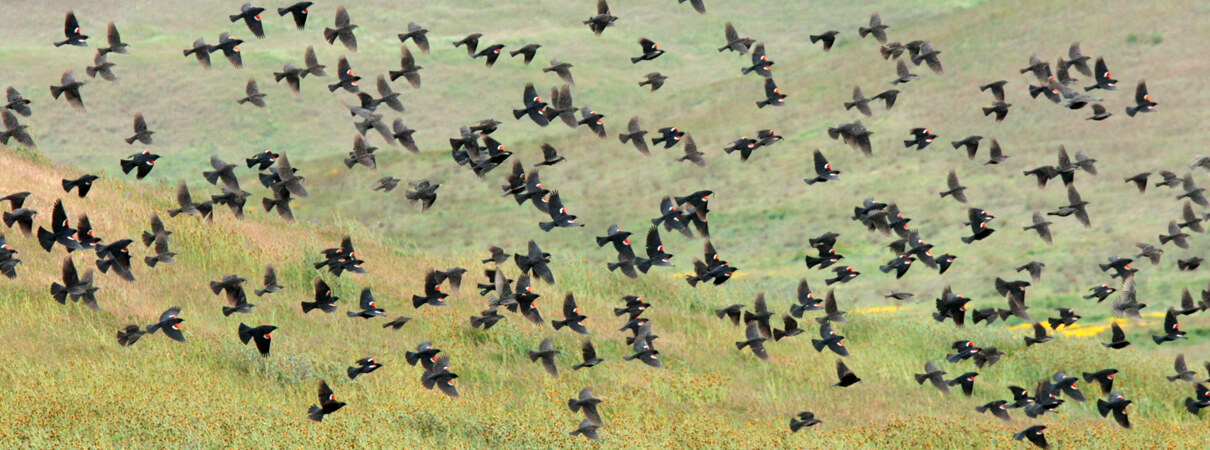 The Tricolored Blackbird closely resembles its near-relative, the Red-winged Blackbird, but males sport white edgings, rather than yellow, on their flashy red wing epaulets. It is nearly endemic to California, where over 95 percent of the global population breeds, mainly in the Central Valley and other points west.
The Tricolored Blackbird closely resembles its near-relative, the Red-winged Blackbird, but males sport white edgings, rather than yellow, on their flashy red wing epaulets. It is nearly endemic to California, where over 95 percent of the global population breeds, mainly in the Central Valley and other points west.
Tricolored Blackbirds form the largest colonies of any North American land bird, with a single breeding colony often numbering tens of thousands of birds. Like the Passenger Pigeon, the colonial nature of the Tricolored Blackbird makes it particularly vulnerable to extinction.
The population of this species is decreasing rapidly, falling from millions of birds in the 1930s to 400,000 birds in 2008, to fewer than 145,000 birds today, a perilous drop of 66 percent in six years.
Many of the habitats once used by Tricolored Blackbirds for nesting and feeding have been lost to urban and agricultural development. Wetlands in its range have declined by more than 95 percent since the arrival of Europeans.
This habitat loss, combined with large-scale breeding failure in harvested agricultural fields, is the most likely causes of recent declines. Hunting and poisoning to control crop depredation took their toll until the 1960s.
Tricolored Blackbirds have many predators, particularly larger birds such as night-herons, ibis, and ravens, and mammals such as coyotes and raccoons. Intense predation can even cause an entire colony to vacate.
Sign up for ABC's eNews to learn how you can help protect birds
Perilous Nesting
Tricolored Blackbirds, like other blackbirds and species such as the Bobolink, are grain-eating birds. They also consume a wide variety of plants and insects, and respond opportunistically to the most abundant, readily available food source. They forage in agricultural areas, particularly where livestock are present and grass is short.
Breeding typically occurs between April and July, when individuals congregate to form breeding colonies. The female builds an open cup nest woven out of vegetation. Typically, four eggs are laid during a first nesting; second nest attempts, with clutches of three or more eggs, are fairly common.
Because of the severe, ongoing drought in California, Tricolored Blackbirds have increasingly turned to nesting in agricultural silage fields, which now hold a significant proportion of the breeding population. Harvesting often occurs when the chicks are just beginning to fledge, which severely limits nesting success: Tens of thousands of nests can be destroyed in a single harvest.
Lack of insect prey and water nearby can also severely limit colony productivity.

Tricolored Blackbird flock by Jacob Spendelow
Farming Tricolor Blackbirds
The Tricolored Blackbird is included on the 2014 State of the Birds Watch List. Already listed as Endangered by the IUCN-World Conservation Union, the species is a now candidate for listing under the U.S. Endangered Species Act (ESA), as well as California's state ESA.
Formerly, the Tricolored Blackbird was exempt from protections provided by 1918's Migratory Bird Treaty Act (MBTA), as most blackbirds and their relatives are considered potential agricultural pests. However, in 1985, the Tricolored Blackbird was removed from the list of exempted species and now is fully protected under the MBTA.
We are partnering with the Tricolored Blackbird Working Group and leading researchers to put immediate conservation measures in place for this species. For example, we're working to secure a conservation easement at a key breeding site that supports 20-30 percent of the entire population during the second breeding period.
Our goal: to halt Tricolored Blackbird decline before it is too late.
Donate to support ABC's conservation mission!



















































